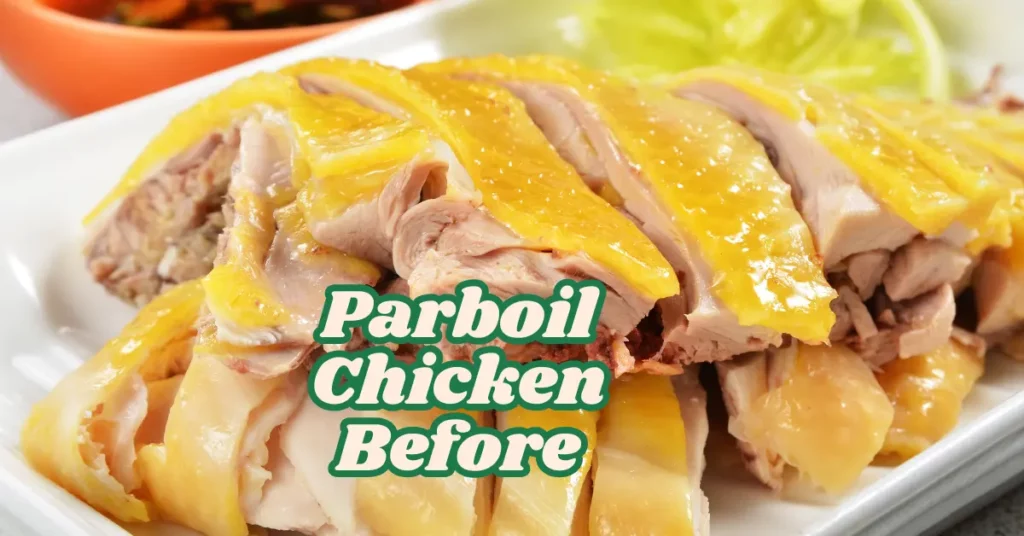This post may contain affiliate links. If you use these links to buy something we may earn a small commission. Thanks.
Grilling chicken is one of the best ways to enjoy a smoky, savory meal but if you’ve ever dealt with burnt outsides and raw centers, you’re not alone. Chicken, especially bone-in cuts, can be tricky to grill perfectly. Fortunately, there’s a simple trick that professional cooks and seasoned grill masters swear by: parboiling.
Parboiling your chicken before it hits the grill can make all the difference. This method helps you achieve juicy, evenly cooked meat without the risk of undercooked parts. In this guide, we’ll walk you through exactly how to parboil chicken before grilling plus offer flavor-boosting tips and common mistakes to avoid.
What is Parboiling?
Parboiling is the process of partially cooking food in boiling water (or broth) before finishing it by another method in this case, grilling. The goal isn’t to cook the chicken all the way through but to get it about 60–70% done so that it cooks faster and more evenly on the grill.
Unlike boiling, where the chicken cooks fully in water, or poaching, which uses lower heat, parboiling is short and controlled. It’s a smart pre-grilling strategy that helps you maintain moisture inside while allowing for crispy charred skin or a smoky finish on the outside.

When Should You Parboil Chicken?
While you can technically grill chicken without parboiling, there are times when it’s incredibly useful:
- Large cuts of chicken like drumsticks, thighs, and bone-in breasts often cook unevenly over direct heat. Parboiling helps ensure they’re cooked all the way through.
- Whole chicken pieces or spatchcocked chickens benefit from even pre-cooking before hitting the grill.
- When you’re short on time, parboiling shortens the overall grilling duration.
- Cooking for a crowd? Parboil in advance, then finish on the grill to serve quickly.
That said, small, thin cuts like boneless, skinless chicken breasts or wings can usually be grilled directly, as they cook quickly.
How to Parboil Chicken Before Grilling
Ready to give it a try? Here’s a full breakdown of the parboiling process from prep to plate.
Ingredients and Tools You’ll Need:
- Raw chicken (any cut: thighs, legs, breasts, wings, or a combination)
- Water or chicken broth (for more flavor)
- Large stockpot or deep saucepan
- Salt
- Optional flavor boosters:
- Bay leaves
- Peppercorns
- Onion slices
- Garlic cloves
- Fresh herbs (thyme, rosemary, parsley)
- Tongs or slotted spoon
- Kitchen thermometer (optional, for checking internal temp later)
Step 1: Clean and Prep the Chicken
Start by rinsing your chicken under cold water and patting it dry with paper towels. Trim off any excess skin or fat if you prefer leaner pieces. While rinsing raw poultry is debated, drying the chicken is important, especially before grilling to ensure a good sear later on.
Step 2: Prepare the Boiling Liquid
Fill a large pot with enough water or broth to cover the chicken pieces. For added depth of flavor, throw in salt, sliced onions, crushed garlic, herbs, or a couple of bay leaves. This liquid won’t just cook the chicken it’ll infuse it with subtle seasoning.
Bring the liquid to a boil over high heat, then reduce slightly to a gentle rolling boil.
Step 3: Add Chicken to Boiling Liquid
Once your liquid is boiling, gently lower the chicken pieces into the pot using tongs or a slotted spoon. Be careful not to overcrowd work in batches if needed.
Return to a simmer rather than a full boil this helps preserve the texture and moisture of the meat.
Step 4: Parboil According to Chicken Cut
Parboiling times vary depending on the cut of chicken and whether it’s bone-in or boneless. Use the following as a guideline:
- Bone-in thighs or drumsticks: 10–15 minutes
- Boneless breasts or thighs: 5–8 minutes
- Wings: 5–7 minutes
- Cut-up whole chicken: 15–20 minutes
- Boneless strips or cutlets: 4–5 minutes
You’re aiming for partially cooked not fully done. The chicken should still be slightly pink in the center.
Step 5: Remove and Rest
Use tongs or a slotted spoon to carefully transfer the chicken from the pot to a plate or tray. Let it cool for 5–10 minutes before grilling. This rest period allows juices to redistribute and the surface to dry slightly — both of which contribute to better browning on the grill.
You can also season or marinate the chicken at this stage if you didn’t flavor the boiling liquid.
How to Grill Chicken After Parboiling
Now that your chicken is partially cooked, it’s time to finish it on the grill.
Step 1: Preheat the Grill
Preheat your grill to medium-high heat (around 375–400°F). Make sure the grates are clean and lightly oiled to prevent sticking.
Step 2: Add Flavor (Optional)
This is the perfect time to brush on a marinade, dry rub, or BBQ sauce. If using a sauce with sugar (like BBQ), wait until the last few minutes of grilling to avoid burning.
Step 3: Grill to Finish
Place the parboiled chicken pieces on the grill and cook for:
- 5–7 minutes per side for thighs and drumsticks
- 3–5 minutes per side for breasts or boneless cuts
- 4–6 minutes total for wings
Use a meat thermometer to check internal temperature. Chicken is safe to eat at 165°F (74°C). Look for a golden brown color and crispy skin.
Flavor Tips and Variations
Want to elevate your grilled chicken even more? Try these tricks:
- Use broth instead of water when parboiling for a richer, more savory taste.
- Marinate after parboiling to layer flavor without long wait times.
- Add lemon slices, chili flakes, or ginger to your parboil liquid for bold profiles.
- Finish with a glaze — honey garlic, teriyaki, or a balsamic reduction are all great choices.
- Grill over indirect heat if the pieces are thick or you’re worried about charring too fast.
Common Mistakes to Avoid
While parboiling is simple, a few missteps can impact your results. Here’s what to watch for:
1. Overboiling
Cooking the chicken too long during parboiling can leave it dry or rubbery after grilling. Stick to the recommended times and check often.
2. Not Seasoning the Liquid
If you use plain water with no salt or aromatics, your chicken might taste bland. Think of the boiling liquid as a flavor bath make it count.
3. Skipping the Rest
Grilling chicken immediately after pulling it from the pot can make it steam instead of sear. Let it rest and dry slightly for better texture.
4. High Heat Only
Especially with bone-in pieces, using only direct high heat can burn the outside before the inside finishes. Consider indirect heat or rotating pieces as needed.
5. Using Too Much Sugar in Marinades
Sugar burns quickly. If you’re using a sweet marinade or sauce, add it at the end of grilling not during the whole time.
Final Thoughts
Parboiling is one of those underrated cooking techniques that can take your grilled chicken from “pretty good” to “absolutely perfect.” By starting your cooking in a pot of simmering, flavorful liquid, you cut down grill time, improve texture, and avoid the all-too-common problem of undercooked interiors.
Whether you’re hosting a summer BBQ, prepping weekday meals, or experimenting with new flavors, parboiling gives you more control and more consistent results. So next time you fire up the grill, give this method a try and get ready for chicken that’s tender, juicy, and grilled to perfection.
